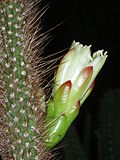|
Brasilicereus
Brasilicereus is a genus of cacti known only from east Brazil and comprising three species.[1] DescriptionThe species of the genus Brasilicereus grow as shrubs with upright, sometimes crooked, rarely branching shoots that reach heights of 1 to 4 meters. The slender shoots can be up to 2.5 centimeters in diameter. They have 3 to 5 flat or narrow ribs. The needle-like, brittle spines are whitish to grayish-brown and arise from areoles covered with gray or white wool. There are 1 to 4 central spines up to 4 centimeters long and 10 to 18 marginal spines 0.5 to 1.5 centimeters long. The flowers, which are short-tubed to bell-shaped, open at night. The flower cup and tube are covered with fleshy scales, and the areoles are glabrous. The dull green to purple fruits are spherical to pear-shaped, with a persistent flower remnant, and do not tear.[2] SpeciesAs of September 2023[update], Plants of the World Online accepted the following species:[1]
References
|
||||||||||||||||||||||||||||||||||||||||||||||||



